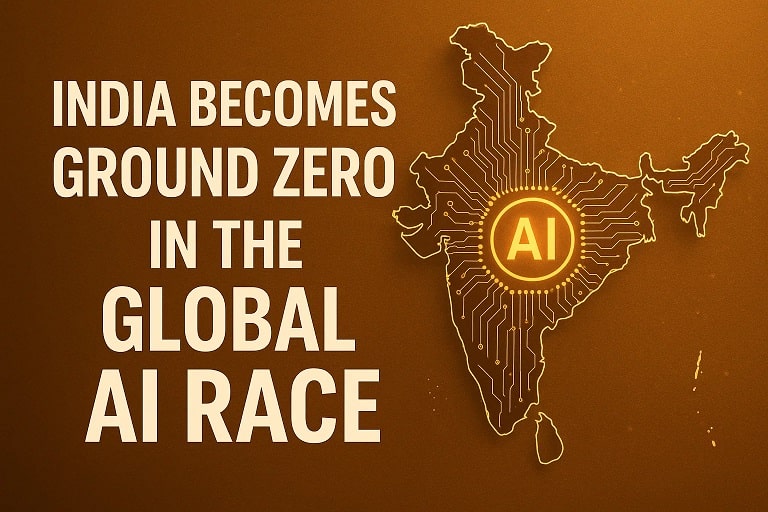India Becomes Ground Zero in the Global AI Race: A Battle for Innovation and Influence
By Editorial Desk | August 25, 2025
India has emerged as the epicenter of the global artificial intelligence (AI) race, transforming from a tech outsourcing hub into a battleground for innovation, talent, and market dominance. With a 1.4 billion-strong population, a 5.4 million-strong tech workforce, and government-backed initiatives like the IndiaAI Mission, global tech giants like OpenAI, Google, and Meta are competing fiercely to capture India’s market while local startups like Krutrim and Sarvam AI push for indigenous solutions. Japan’s $68 billion investment pledge and Kyndryl’s $2.25 billion tech commitment further underscore India’s strategic importance. However, funding gaps, infrastructure challenges, and geopolitical tensions pose risks to India’s AI ambitions. This article provides a comprehensive analysis of India’s role in the global AI race, supported by data in tables and answers to frequently asked questions, drawing on recent developments and web sources.
Overview of India’s AI Surge
India’s rise as a global AI hub is driven by its massive market, talent pool, and strategic initiatives. OpenAI’s entry into India, announced in August 2025, with a New Delhi office and the affordable ChatGPT Go plan at ₹399/month, has sparked a price war among tech giants. Google, Perplexity AI, xAI, and Grammarly are offering competitive subscriptions, while Reliance Industries’ 3-gigawatt AI data center in Jamnagar and NVIDIA partnerships signal infrastructure growth. The IndiaAI Mission, backed by ₹20,000 crore ($2.4 billion) for FY26, aims to develop indigenous large language models (LLMs) and multimodal models, with 18,693 GPUs secured for research. India’s 24% share in global AI projects on GitHub and a projected $17 billion AI market by 2027 position it as a leader, though funding disparities ($780 million for Indian AI startups in 2024 vs. $109 billion in the U.S.) highlight challenges.
From IT Hub to AI Powerhouse
India’s tech journey began with IT services in the 1990s, leveraging its English-speaking workforce and low costs. By 2025, India produces 1.5 million engineering graduates annually, with 4.7 million working in AI/ML roles globally. The IndiaAI Mission, launched in March 2024, builds on earlier policies like the 2018 National AI Strategy, aiming for a $500 billion GDP contribution by 2030. Key milestones include:
- Digital India Bhashini: Supports 350+ AI models for 22 Indian languages, enhancing accessibility.
- Reliance-NVIDIA Partnership: A 1-gigawatt Gujarat data center for sovereign AI models like Indus 2.0.
- Global Recognition: Stanford’s AI Index ranks India fourth among AI superpowers, with 24% of global AI project contributions.
Geopolitical dynamics amplify India’s role. U.S.-China tech tensions, coupled with U.S. tariffs (50% on Indian exports), position India as a neutral hub for AI investment, attracting $3.5 billion in FDI in 2023–24. However, India’s AI funding ($7.25 billion total) lags behind the U.S. ($109 billion) and China ($8.2 billion), risking dependency on foreign models.
India’s AI Ecosystem
Government Initiatives
- IndiaAI Mission: ₹20,000 crore ($2.4 billion) for FY26, up 1056% from ₹173 crore, to develop LLMs, multimodal models, and infrastructure like 27 Data & AI Labs in Tier 2/3 cities.
- AI for India 2030: Targets $500 billion GDP contribution via AI in agriculture, healthcare, and MSMEs.
- Digital India Bhashini: 350+ language models for Automatic Speech Recognition, Machine Translation, and OCR, supporting 22 Indian languages.
- GPU Allocation: 18,693 GPUs (13,000 NVIDIA H100s) for startups and researchers, exceeding the 10,000-GPU target for FY25.
Industry Developments
- Global Players:
- OpenAI: ChatGPT Go at ₹399/month, with UPI integration and OpenAI Academy for AI literacy.
- Google: Gemini Premium at ₹1,950/month, free Pro access for students, integrated with Android and Docs.
- xAI: SuperGrok at ₹700/month, targeting affordability.
- Perplexity AI: Free Pro plan via Airtel partnership.
- Local Startups: Krutrim, Sarvam AI (Sarvam 1 LLM in 10 Indian languages), and BharatGPT focus on India-specific models, though they face talent and funding competition.
- Reliance’s Jamnagar Data Center: A $20–30 billion, 3-gigawatt facility, aiming for the world’s lowest AI inferencing costs, powered by solar and wind.
Strategic Partnerships
- NVIDIA: Collaborates with Reliance, Infosys, TCS, and Wipro, training 500,000 AI developers by 2025.
- Microsoft: $3 billion investment, training 10 million in AI skills by 2030, with 2.4 million trained in 2024 (65% women).
- Meta-IIT Jodhpur: Center for Generative AI (Srijan) to develop India-specific models.
Market and Social Media Sentiment
- Stock Impact: Nifty 50 gained 1.5% post-OpenAI’s India announcement, with tech stocks like TCS up 3%.
- X Sentiment: Posts highlight India as OpenAI’s second-largest market, with GPT-5 tailored to Indian feedback, though some express skepticism, calling India a “data extraction hub” for global tech giants.
Trends and Implications
Strategic Rationale
India’s 1.4 billion population, 800 million internet users, and 14 billion monthly UPI transactions create a unique AI testbed. The IndiaAI Mission’s focus on sovereign models like Indus 2.0 ensures linguistic and cultural relevance, while partnerships with NVIDIA and Microsoft bolster infrastructure. Japan’s $68 billion investment, including AI and semiconductors, and Kyndryl’s $2.25 billion tech commitment reinforce India’s global appeal. OpenAI’s Sam Altman called India a “testbed for scalable AI adoption,” shaping strategies for the Global South.
Industry Trends
- Price War: Affordable subscriptions (e.g., ChatGPT Go at ₹399/month) mirror Reliance Jio’s telecom disruption, democratizing AI access.
- Sovereign AI: India prioritizes local models to reduce dependency, with Sarvam AI’s LLM supporting 10 Indian languages.
- Edge AI: Multiverse Computing’s 95% model compression enables AI on low-resource devices, aligning with India’s edge computing push.
- Geopolitical Advantage: India’s democratic ecosystem attracts FDI as an alternative to China’s controlled AI environment.
Economic and Social Impacts
- Economic Growth: AI could add $500 billion to India’s GDP by 2030, with 38 million jobs transformed by 2030.
- Sectoral Transformation:
- Agriculture: AI drones and analytics boost yields by 21% for 7,000 farmers.
- Healthcare: AI diagnostics cut misdiagnoses by 25% for diabetes-related issues.
- Education: Personalized learning via Microsoft’s AI tools reaches 6 million students.
- Job Creation: Skilling initiatives target 10 million workers, with 65% women, bridging urban-rural divides.
Challenges
- Funding Gap: Indian AI startups raised $780 million in 2024 vs. $109 billion in the U.S., limiting proprietary model development.
- Infrastructure: Despite 18,693 GPUs, India lags in high-performance computing compared to U.S. and China.
- Talent Retention: 16% of global AI talent is Indian, but many move abroad due to better resources.
- Data Quality: Curated, India-specific datasets are critical for relevant models but remain limited.
- Regulatory Risks: The Finance Ministry’s ban on tools like ChatGPT for official use highlights privacy concerns.
Future Projections
India’s AI market is projected to reach $17 billion by 2027, growing at 25–35% annually. The IndiaAI Mission could yield six foundational models by 2026, with Reliance’s Jamnagar facility driving low-cost inferencing. Japan’s investment and local startups like Sarvam AI may reduce foreign dependency, but scaling infrastructure and funding to match U.S. ($500 billion Stargate project) and China ($8.2 billion) remains critical. India’s focus on ethical AI and 27 new AI labs could position it as a global leader by 2030, though talent retention and data governance will determine success.
India’s AI Ecosystem Snapshot (2025)
Metric | Value | Details |
|---|---|---|
AI Market Size | $17B by 2027 | 25–35% CAGR, per Nasscom-BCG |
Funding (2024) | $780M | Vs. $109B in U.S., per Deccan Herald |
GPU Allocation | 18,693 | Includes 13,000 NVIDIA H100s |
AI Talent | 4.7M | 16% of global AI professionals |
GitHub AI Share | 24% | Second-largest contributor globally |
Key AI Players in India (2025)
Entity | Offering | Details |
|---|---|---|
OpenAI | ChatGPT Go | ₹399/month, New Delhi office |
Gemini Premium | ₹1,950/month, free Pro for students | |
xAI | SuperGrok | ₹700/month, affordability focus |
Sarvam AI | Sarvam 1 LLM | Open-source, 10 Indian languages |
Reliance-NVIDIA | Jamnagar Data Center | 3-gigawatt, $20–30B investment |
FAQs
Why is India considered ground zero in the global AI race?
India’s 1.4 billion population, 5.4 million tech workforce, and government initiatives like IndiaAI Mission attract global players like OpenAI and Google, while local startups push sovereign models.
What is the IndiaAI Mission?
A ₹20,000 crore ($2.4 billion) initiative to develop LLMs, multimodal models, and infrastructure, with 18,693 GPUs and 27 AI labs.
How are global tech giants engaging with India?
OpenAI’s ChatGPT Go (₹399/month), Google’s Gemini Premium, and xAI’s SuperGrok target affordability, while Microsoft and NVIDIA invest in skilling and infrastructure.
What role do Indian startups play?
Krutrim, Sarvam AI, and BharatGPT develop India-specific LLMs, but face funding and talent competition from global giants.
What are India’s AI infrastructure developments?
Reliance’s 3-gigawatt Jamnagar data center, Yotta’s 16 exaflops Mumbai facility, and Microsoft’s four data centers drive AI computing.
How does Japan’s $68 billion investment impact India’s AI race?
It supports AI, semiconductors, and clean energy, strengthening India’s tech ecosystem amid U.S. tariffs.
What challenges does India face in AI?
A $780 million funding gap, limited high-performance computing, talent retention issues, and data quality constraints hinder progress.
How does India address linguistic diversity in AI?
Digital India Bhashini supports 350+ models for 22 Indian languages, with Sarvam AI’s LLM covering 10 languages.
What is the economic impact of AI in India?
AI could add $500 billion to GDP by 2030, transforming 38 million jobs in agriculture, healthcare, and education.
What’s next for India’s AI ambitions?
Scaling to a $17 billion market by 2027, launching six foundational models by 2026, and leveraging FDI to reduce dependency on foreign AI.












